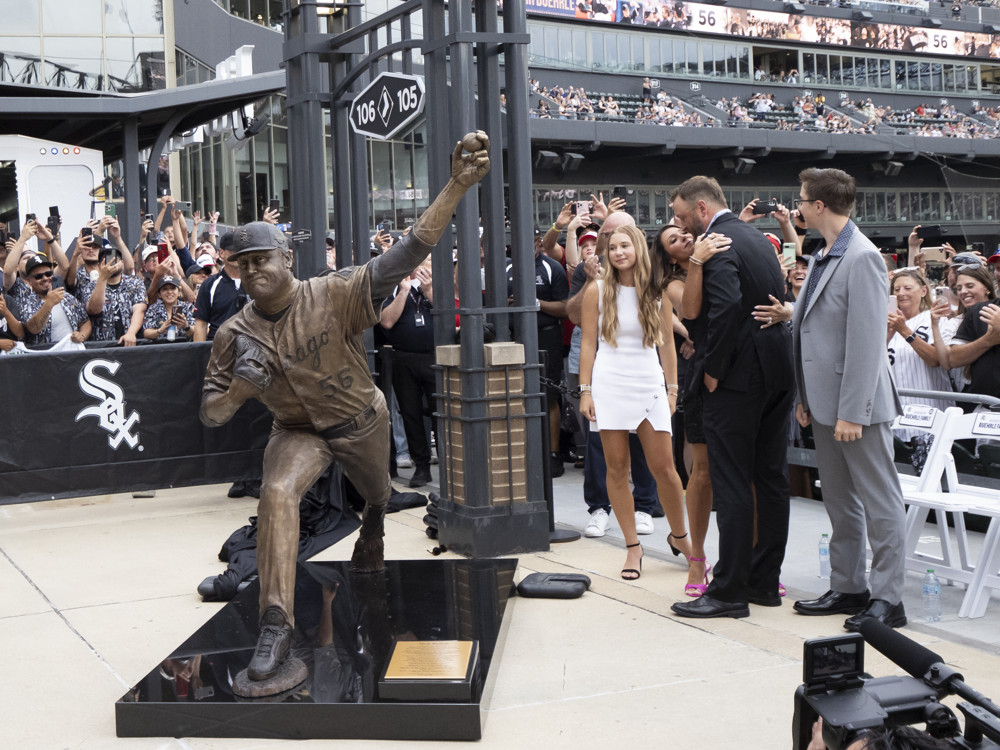The first thing to know about the new statue honoring Mark Buehrle on the right field concourse is that it will look like a lot of the others for good reason.
The 350-pound bronze sculpture was created by Lou Cella, who has been working out of the Highwood-based Rotblatt Amrany studio for the last 30 years. His relationship with the White Sox began when he was commissioned to sculpt a statue of Carlton Fisk in 2005.
Fisk and his wife said that Cella might have embellished his muscles a little bit, but didn't let that get in the way of a rave review, and so began a steady relationship that has seen the sculptor produce statues of the 2005 World Series championship, Frank Thomas, Paul Konerko and Minnie Miñoso that now make up the decor at Rate Field. He also worked on the statue of famed broadcaster of Ernie Harwell at Comerica Park and Billy Williams at Wrigley Field.
"My two favorite things in life are baseball and sculpting," Cella said. "So when I get to sculpt a baseball player for any team, at any level, it's a lot of fun for me. I really enjoy it, and I don't want it to end. I want to keep working on it. I keep tinkering around until the deadline is on me."
The deadline is long past, but the unveiling of Buehrle's statue is the culmination of a year of work for Cella, which he said was the "brainchild" of White Sox chairman Jerry Reinsdorf. The choice to memorialize Buehrle throwing the final pitch of Game 3 in the 2005 World Series also came from the team. But from there, capturing Buehrle's image, the details of his uniform and trying to distill the feeling of watching one of the best command artists of his generation into a motionless statue, came down to Cella, along with plenty of help and repeated visits from the subject.
That video shows Cella working with his preferred medium of clay, which is just one interstitial step of an exhaustive process. The studio's preferred format is to begin with a two-dimensional design, before welding a a three-dimensional metal framework of Buehrle in action referred to as an armature. Again, that's only the start.
"It's like a stick figure or a skeleton in the pose of the player," Cella explained. "Then you apply wood to that metal to bulk it up a little, and then screws are sunk into the wood. They stick out an inch or two, and it looks like a big pincushion. Those screws are a couple of inches apart, and what you use them for is to take this heavy gauge wire. It's like a clothesline, but it's wire, and you wrap the wire around the screws, back and forth over the whole thing. You're creating a mesh."
It's here where the clay itself is finally applied and Cella can start shaping the structure into Buehrle's image, and obsessing over the fine details -- pores on the skin, how his hair came out from under the cap, the stubble on his cheek -- that he feels elevate the statue into something truly evocative. But the clay itself is still just a mold for a larger operation.
"After the clay has been approved, we put a rubber mold on there; just liquid rubber is applied in multiple layers," Cella said. "Before we peel it off, we put plaster on top of the rubber, and that's quite thick, an inch or two of plaster. It's all done sectionally. Once the plaster cures, you're removing sections like a clam shell. Once you take the plaster off, you take the rubber off and lay those rubber sections in the plaster sections you just removed so they can nest in there and take their shape. Now we essentially have a rubber impression of Mark Buehrle, but it's a negative impression.
"Those get shipped off to a bronze foundry, where they put wax into those rubber molds. It's molten wax and they pour it in and brush it. They will build the wax in there to a quarter of an inch thick. It cures and they remove the wax sections, and now we are left with a wax statue of Mark Buehrle that looks just like my clay statue. They put yet another mold on top of the wax, they call this a slurry. The slurry is a ceramic composite. They cut a little opening in it that exposes the wax. That slurry is heat resistant, but they expose the wax in one area and they put the whole thing in a blast furnace. That's heated up, the slurry is affected by the heat, melts and evacuates the mold. You're left with the hollow slurry, you turn that over and pour molten bronze where the wax was.
"When it cools, you chip off the slurry shell and you are left with bronze pieces of Mark Buehrle all over the floor that look very crude. Those are cleaned up and welded together."
There's a colored patina -- black in this case, as it's the White Sox and that's what the good guys wear -- that's subsequently is applied to the bronze which serves to highlight all the details that Cella labored over. He applied real uniform buttons into the clay, Buehrle allowed him to use a game-used glove that had to be cut open to fit onto the mold. The haziness of memory collided with Cella's perfectionism as he sought out a pair of Nike Shox cleats, which Buehrle didn't remember wearing for a particularly long stretch of his career, but happened to have on the night he volunteered to pitch the 14th inning some 20 years ago.
"He was one of two players I've ever had put on a uniform and pose for me," Cella said. "He just started throwing baseballs and I was photographing him, walking around and around. I was even standing directly in front of him behind that screen he was throwing the ball into. At some point he said 'You can stand away from the screen, I won't hit you.' And then it dawned on me that this wasn't some guy from the neighborhood throwing the ball, this was a guy who threw two no-hitters."
With Cella obsessing over details like how Buehrle would bite his bottom lip mid-pitch, items like the diamond sock on one sleeve of his uniform and the World Series patch on the other were gimmes for him. With Buehrle being who he is, unlikely to vocalize criticisms even if he had them, Cella had come to rely on White Sox vice president of communications Scott Reifert for feedback and suggestions for adjustments. And at a later hour, after the 1,000-pound clay mold had already been shipped out to the bronze foundry, Reifert notified Cella of a big one:
Apparently, Buehrle's jersey had no World Series patch on it.
There was never an explanation for why that was the case, but as Cella furiously reviewed old video and photos of Buehrle's Game 3 appearance, he realized it was true. No one would ever think that a World Series patch was out of place on a statue of Buehrle literally pitching in the World Series, but Cella strives for authenticity and called the foundry.
"It's a lot easier to take it off than to put it back on, and they did," Cella said. "It's from the greatest season from the history of the franchise. It's going to be super historic and special forever. We wanted it represented."
Eventually, that intent rubbed off on Buehrle a little too, and he did provide feedback on his arm angle and details of the leg stride that produced 16 years of dotted strikes. But his easygoing nature was hard to keep down for long.
"I said to him, 'If that cover comes off and Bruce Levine is standing there asking me why I didn't get that arm angle right, I'm going to be in a tough position,'" Cella said. "He started laughing and said, 'Oh, tell Bruce to screw off -- no, I'll tell Bruce to screw off.'
"We made some changes and we got it corrected. And when he came to Chicago, he was very happy with how everything looked. He went to SoxFest and when he greeted the reporters, Bruce was standing up front and he walked right up to Bruce and wrapped his arms around him. It was really fun."






